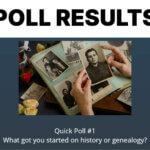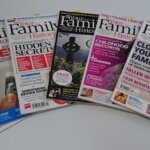The end of the year is almost here the year, which for many can’t come quick enough. 2020 has certainly been an odd year, but one that I hope you’ve documented in some way for your future generations to know what it was like as someone going through the pandemic. You are living through history, so record it through your eyes.
Anyway I still find that I get a lot of great tips and ideas and inspiration from reading other’s experiences, so that’s why I compile these lists. Anyway as I haven’t given you any Inspiring Genealogy Blogs posts since July we have a big list for you here!
In this one we cover: In this edition of Inspiring Genealogy Blogs we cover: Missing records, disaster preparedness, the AJCP, DNA matches, timelines, tree hints, baby books, presentism, zoom, handwriting … and so much more!! So find a comfy chair, and enjoy some great reading.
As I mention every time, I find that reading blog posts helps me keep up with the latest news, products as well as what’s happening in general in the world of genealogy. And if you happen to already follow me on Facebook and Twitter, you already know that I like to share with you the interesting things I read.
—————————————-
Simple Tips For Reading Old Handwriting in Genealogy Documents!
Reading old handwriting in genealogy documents can be tough for a variety of reasons … Faded ink, poor penmanship, unusual script to name a few, but then add in abbreviations or a different language and your job of interpreting it just got harder. Lisa Lisson gives you some simple to follow when reading old handwriting. Read the full article here …
6 Things to Do When Your DNA Match Doesn’t Have a Tree
You’ve taken a DNA test, and your results show a bunch of matches, but no-one has trees!! So you’re tearing your hair out. All is not lost, genetic genealogist Diahan Southard, has come up with 6 things you can try for those matches that have no trees. Read the full article …
Disaster Preparedness
Many of us live in areas exposure to natural disasters such a hurricanes, tornados and earthquakes. While there is some predictability to weather fluctuations it is the unexpected events such as fires and floods that change our lives. Maureen Taylor (aka The Photo Detective), tells us there are four steps to the disaster planning process: prevention, preparedness, response and recovery. And while most museums, libraries, and archives have disaster plans and she says that YOU should too. Read the full article …
Digital Images from AJCP
In this post Carmel introduces readers to AJCP. She writes “The Australian Joint Copying Project (AJCP) is a collection of unique historical material relating to Australia, New Zealand and the Pacific dating from 1560 to 1984. What a wealth of material can be found in these digitised records. These records can now be browsed through Trove.” Interested in finding out more about them, and how to use these records? Read the full article …
3 Types of Timelines for Genealogy Research
Do you use timelines at all as a part of your research? Did you know there are different types of timelines? Have a read of this article to see what the different ones are, and how they can be useful for your research. Read the full article …
Living With a Family Historian
Written by a non-genie as a guest post on the Genealogical Society on Queensland blog. From detours to cemeteries and BDM registrars, to deciphering “scratch writing”, to holidays to “family” places … I’m pretty sure that all of our partners can relate to this. Read the full article …
From the Archives – Pointers for Presenters
For presenters of both in person events, and those who present virtually, Jill Ball has updated her pointers for presenters list and has plenty of great suggestions. Read the full article …
Where Have All the Registers Gone?
David Annal writes a really interesting article about records that is missing from the big-name-sites, and gives various examples about how someone would search, not find anything and assume that that person wasn’t married there, or buried there. No, in fact it is known that in some cases a whole register has been missed when the records were being digitised. Read the full article …
Genealogy Basics Chapter Five: Digitizing and Storing Documents and Photos
Periodically MyHeritage add a new chapter to their “Genealogy Basics” collection. In this one they write about how to digitise and store your photos and documents. Scanning and digitising your documents is not just an easy way to preserve them for yourself and for future generations, but it also makes it easier to organise, browse, and share files with other family members. You find plenty of good tips mentioned here, to help you with yours. Read the full article …
Export Your Tree From Family Tree Maker in 5 Steps
It’s all good having your tree in a genealogy program, but you need to know how to get it out of it as well, for a backup if nothing else. But also if you wish to transfer your family tree to new software or you just want to share it with relatives, you’ll need to know how to export a family file. Here’s how to do this in Family Tree Maker 2019. Read the full article here …
Guarding Against Presentism: How Historical Facts (Should) Affect Your Research Strategy
How often do we view ancestors doings in ‘presentism’ rather than putting them into the context of the era? All too often sadly. Learning the social history of the time and place is just as important as finding out the details of your family. It helps to understand so many of “why they did things” queries. Read the full article …
Time Out! Why Even Long-Time Genealogists Need a Break
It’s frustrating, you’v e been on the hunt for a person for months or even years, and still no sign of him. New records came online, but still no record of him. It’s ok to take a break, in fact it is advisable to do so. Choose a different line, or have a break from genealogy altogether for a bit. You will come back with fresh eyes, less frustration and may well crack that brickwall. Read the full article …
Baby Books are More than Just Memories
In the list of resources to check out for historical information, how many of your have (or use) baby books? There’s usually a whole heap of fabulous information included, but so often they are overlooked as a resource. Read the full article …
10 Rules for Accepting (or Rejecting) Online Family Tree Hints
You’ve all seen them, the ‘shaky leaves’ or equivalent on other sites advising that there are “hints” relating to a record in your tree. But before going ahead an adding it to your tree Sunny Morton who has written this article for Family Tree Magazine, gives you some good advice on how to how to separate “good tree hints with mismatches”. Read the full article …
How Zoom can help family history societies to survive and evolve
Chris Paton write about how the pandemic and Zoom have changed (and saved) many genealogy societies. He writes … “many family historians who have in the past given talks to family history societies are now doing so online. It’s an eloquent situation, but it is one that has its pros and its cons’’. He gives readers an overview and some thoughts that might help groups who may not have taken that step into online talks yet, to decide to go for it! Read the full article …
A Comparison of the Big Four Genealogy Websites
It’s a common question, which one should I subscribe to? How are they different? Sunny Morton writes all about “the big four” Ancestry, Findmypast, MyHeritage and FamilySearch, and details how they differ? Read the full article …
Happy reading!! 🙂









